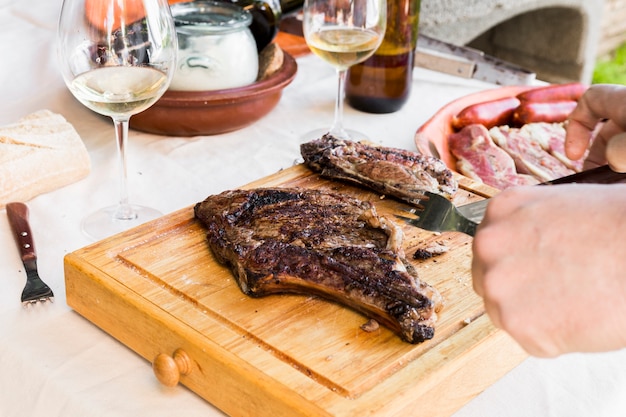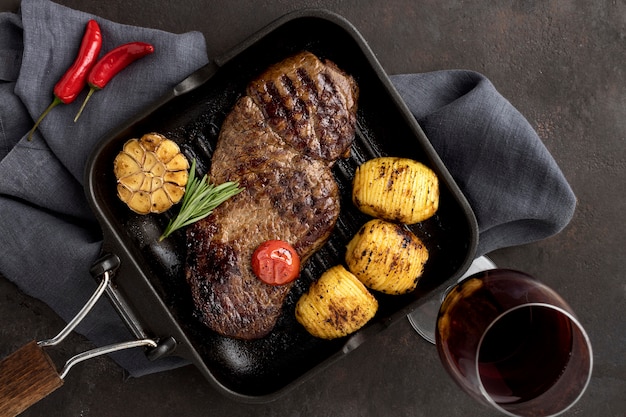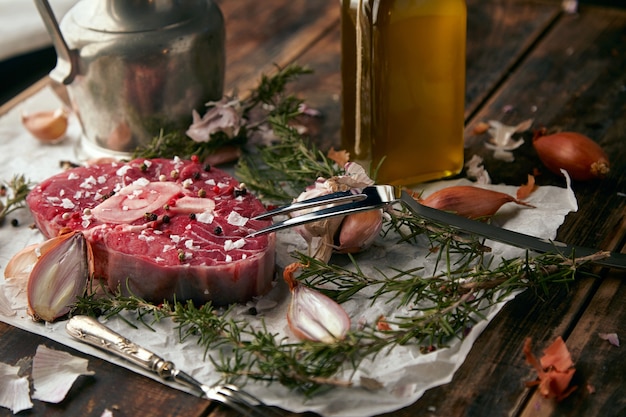Ah, steak. The mere mention of the word conjures up images of sizzling, juicy meat, a smoky aroma filling the air, and the promise of a truly satisfying meal. For me, there's nothing quite like a perfectly cooked medium-rare steak – that blushing pink center, the melt-in-your-mouth tenderness, the delightful contrast of a crispy crust. But achieving this culinary nirvana can be a bit of a journey, especially for those of us who haven't quite mastered the art of steak cooking.
Don't worry, my fellow steak enthusiasts! I've been there too, spending countless hours experimenting with different techniques, trying out all sorts of gadgets, and poring over cookbooks. And along the way, I've picked up a few tips and tricks that have helped me achieve that elusive medium-rare perfection. So, grab your favourite apron, pour yourself a glass of something refreshing, and let's embark on this culinary adventure together.
(Part 1) choosing the right cut: The Foundation of a Great Steak

Let's be honest, the steak you choose is the foundation of your entire culinary masterpiece. Not all cuts are created equal, especially when it comes to achieving that coveted medium-rare finish. You need a cut that's not only flavorful and tender but also holds up well to heat, yielding a beautiful char while staying juicy inside.
The Best Cuts for Medium-Rare Perfection
- Rib-eye: My personal favourite, this cut is a true king of the grill. Its generous marbling of fat, interspersed throughout the meat, creates a rich, buttery flavour and ensures succulent tenderness. It's a perfect choice for grilling or pan-frying, offering a fantastic balance of flavour and texture.
- new york strip: Another fantastic choice, the New York strip boasts a leaner profile than the rib-eye, but it doesn't compromise on flavour or juiciness. This makes it a great option for grilling or pan-frying when you want a steak with a bit more lean meat.
- filet mignon: For a truly special occasion, the filet mignon takes centre stage. Known for its unparalleled tenderness and buttery richness, it's a classic choice for a romantic dinner. While it might be a bit pricier than other cuts, it's truly a delightful experience for your taste buds.
- Sirloin: This is a leaner cut that's fantastic for grilling. While it can be slightly tougher than other cuts, proper preparation with marinades and precise cooking methods can transform it into a delicious and satisfying meal.
- flank steak: A flavourful and lean cut, the flank steak is a versatile choice for grilling, stir-fries, or marinating. It's a great option when you want a leaner cut with a strong, robust flavour.
Choosing the Right Cut for You
Thickness: When it comes to medium-rare, thicker steaks are your best friends. Aim for a steak at least 1 inch thick, but ideally 1.5 inches or more. This ensures even cooking and prevents the steak from drying out.
Marbling: Don't underestimate the power of marbling! Those streaks of fat are what create juicy, flavorful steak. Look for a steak with good marbling, which will contribute to a richer, more satisfying eating experience.
Colour: A good steak should have a vibrant, bright red colour. Avoid steaks that have a dull or grey hue, as this could indicate a lack of freshness or quality.
(Part 2) The Art of Preparation: Setting the Stage for a Delicious Steak

Now that you've chosen your perfect cut, it's time to get ready for the cooking process. Preparation is paramount for a juicy, flavorful steak.
Pat It Dry
The first step is to pat your steak dry with paper towels. This might seem like a minor detail, but it's crucial. A dry surface allows for a much better sear, creating that crisp, golden-brown crust we all crave.
Seasoning: A Symphony of Flavours
Next comes the fun part – seasoning! This is where you can let your creativity shine, adding your personal touch to the flavour profile. However, the classics are often the best.
- Salt and pepper: A generous amount of both is essential for a truly delicious steak. I prefer using coarse salt, as it creates a more robust crust.
- Garlic powder: For a hint of earthy depth, add a sprinkle of garlic powder.
- Paprika: A dash of paprika introduces a subtle smoky flavour, adding another dimension to your steak.
- Herbs: Fresh or dried herbs, like rosemary, thyme, or oregano, can really elevate the flavour. You can use a simple combination or experiment with your favourite herb blends.
Let It Rest
Before you start cooking, give your seasoned steak a little rest at room temperature for about 30 minutes. This allows it to come closer to room temperature, promoting more even cooking and preventing a sudden shock when it hits the heat source. It also helps achieve a better sear.
Don’t Overwork It
Resist the urge to pound or tenderize your steak. This might seem like a good idea, but it actually releases moisture and can make the steak tough. Let the steak's natural texture shine through.
(Part 3) The Cooking Process: The Moment of Truth

Now, we're getting to the heart of the matter – the actual cooking!
Grilling: The Classic Method
Preheat Your Grill: A hot grill is crucial for a good sear. Aim for medium-high heat, which should be around 400°F (204°C). You can test the heat by holding your hand a few inches above the grill; it should be hot but not uncomfortable.
Oil the Grill: To prevent the steak from sticking, lightly brush the grill grates with oil. You can use a heat-resistant brush or a paper towel to apply the oil.
Sear It: Place the steak on the hot grill and cook for 2-3 minutes per side, undisturbed. Resist the urge to move it around too much during this crucial searing stage. You want to create a nice, crispy crust that locks in the juices.
Reduce the Heat: Once you've achieved a good sear, lower the heat to medium. Continue cooking for another 3-5 minutes per side, or until the internal temperature reaches 130°F (54°C) for medium-rare.
Rest: Remove the steak from the grill and let it rest for 5-10 minutes before slicing and serving. This allows the juices to redistribute, resulting in a more tender and juicy steak.
Pan-Frying: A Versatile Option
Heat Your Pan: Use a cast-iron skillet or a heavy-bottomed pan. Let it get incredibly hot. You want the pan to be screaming hot before you add the steak.
Oil the Pan: Add a tablespoon or two of oil, ensuring the pan is well coated.
Sear It: Place the steak in the hot pan and sear for 2-3 minutes per side. You're looking for a crispy crust that's golden brown and delicious.
Reduce the Heat: Lower the heat to medium and continue cooking for another 3-5 minutes per side, or until the internal temperature reaches 130°F (54°C).
Rest: Let it rest for 5-10 minutes before slicing and serving.
Tips for Successful Steak Cooking
Don’t Overcrowd the Pan: Give your steaks space to cook properly. Overcrowding the pan will lead to uneven cooking and a less flavorful result.
Don’t Press Down on the Steak: Let it cook naturally. Pressing down on the steak will squeeze out the juices, leading to a drier, less juicy steak.
Use a meat thermometer: This is the most reliable way to ensure your steak is cooked to your liking. Insert the thermometer into the thickest part of the steak, avoiding bone, and ensure it's at the desired temperature before taking the steak off the heat.
(Part 4) Checking the Doneness: Knowing When It’s Perfect
Knowing when your steak is cooked to perfection is crucial, especially for those of us aiming for that medium-rare bliss.
Temperature Guide: A Handy Reference
This temperature guide is a great starting point, but always double-check with a meat thermometer for accurate results.
| Doneness | Internal Temperature (°F) | Internal Temperature (°C) |
|---|---|---|
| Rare | 125-130 | 52-54 |
| Medium-rare | 130-135 | 54-57 |
| Medium | 135-140 | 57-60 |
| Medium-well | 140-145 | 60-63 |
| Well-done | 145-150 | 63-66 |
Checking Doneness: Methods and Tips
The Finger Test: This traditional method is a handy guide, but it's not as accurate as a meat thermometer. Press the pad of your finger against your palm – the feeling should be similar to the firmness of your steak at different doneness levels. However, it's best used as a general indicator.
The Meat Thermometer: The most reliable method for accurate results. Insert the thermometer into the thickest part of the steak, avoiding bone, and ensure it's at the desired temperature before removing it from the heat source.
(Part 5) The Importance of Resting: A Crucial Step for Juiciness
Once your steak is cooked to your liking, resist the temptation to slice into it right away. It's crucial to let it rest before cutting and serving.
Why Resting Matters
Redistributes Juices: During cooking, the heat forces juices towards the center of the steak. Resting allows those juices to redistribute back throughout the meat, ensuring a more tender and juicy outcome.
Tenderizes: Resting allows the muscle fibers to relax, contributing to a more tender, enjoyable eating experience.
How to Rest
Cover It: Wrap the steak loosely in aluminum foil and let it rest for 5-10 minutes. This helps keep it warm and prevents it from drying out.
(Part 6) Slicing and Serving: Bringing Your Steak to the Table
Now it's time to enjoy the fruits of your labour.
Slicing
Against the Grain: Cut your steak against the grain, meaning cut perpendicular to the muscle fibers. This makes it easier to chew and results in a more tender, enjoyable eating experience.
Thickness: Cut the steak into slices about ?? inch thick, ensuring the slices are consistent and easy to handle.
Serving
Presentation: Arrange the sliced steak on a platter, creating a visually appealing presentation.
Sides: Serve it with your favourite sides, such as mashed potatoes, roasted vegetables, creamy polenta, or a fresh, crisp salad.
Sauce: If you want to add a sauce, choose one that complements the flavour of the steak. For example, a rich, creamy béarnaise sauce or a tangy chimichurri sauce are fantastic choices.
(Part 7) Tips for Avoiding Common Mistakes
We've all been there – overcooked steak, tough steak, dry steak – the list goes on. But don't despair! There are ways to avoid these common pitfalls and achieve that perfect medium-rare steak.
Overcooking
Don’t Overcook It: This is the most common mistake. Remember, the longer you cook a steak, the tougher it will become. Pay close attention to the cooking time and use a meat thermometer to ensure you don't overshoot your target temperature.
Use a Meat Thermometer: This is your best friend when it comes to steak cooking. It eliminates any guesswork and ensures your steak is cooked precisely to your liking.
Tough Steak
Choose the Right Cut: Some cuts are naturally tougher than others. Consider leaner cuts like sirloin or flank steak, which require careful preparation and cooking.
Tenderize: For tougher cuts, you can use a meat mallet to tenderize the fibers. However, remember to be gentle and avoid over-tenderizing, as this can result in a dry steak.
Marinate: Marinating a steak for at least 30 minutes before cooking can help tenderize the meat and add flavour. Use a marinade that complements the cut and your desired flavour profile.
Dry Steak
Don’t Overcook It: Overcooking is the biggest culprit behind a dry steak. Pay close attention to the cooking time and use a meat thermometer to ensure you don't overcook.
Pat It Dry: Before cooking, pat your steak dry with paper towels to remove excess moisture. This will help create a crispier crust and prevent steam from forming during cooking.
Rest It: Always let your steak rest for 5-10 minutes before slicing and serving. This allows the juices to redistribute throughout the meat, resulting in a more tender and juicy steak.
(Part 8) FAQs: Addressing Common Concerns
Now, let's tackle some of the most frequently asked questions about cooking steak.
1. Can I Cook a Steak from Frozen?
While you can cook a steak from frozen, it's not ideal. It will take longer to cook evenly, and the outside might cook too quickly, leading to a dry, uneven steak. It's best to thaw the steak in the refrigerator overnight for the best results.
2. What’s the Best Way to Marinate Steak?
The best marinade depends on the cut and your desired flavour profile. A simple marinade of olive oil, soy sauce, and garlic is a good starting point. For a bolder flavour, you can add other ingredients like lemon juice, red wine, honey, or herbs. Marinate for at least 30 minutes, but longer is often better.
3. Can I Use a cast iron pan for Grilling?
Absolutely! A cast-iron pan is a fantastic alternative to a grill. Simply heat the pan over high heat, allowing it to get incredibly hot before adding the steak. You can even create grill marks by using a grill pan or criss-crossing the steak with tongs during searing.
4. How Do I Make a perfect steak Crust?
A hot grill or pan is essential for a perfect crust. Season generously with salt and pepper before cooking. Don't move the steak around too much during searing. This allows the meat to brown properly and create that delectable crispy crust.
5. What’s the Best Way to Clean My Cast Iron Pan?
After cooking, wash the pan with hot water and a little soap. Avoid using harsh detergents or scouring pads, as these can damage the seasoning. Dry it thoroughly and coat it with a thin layer of oil to prevent rusting.
(Part 9) Conclusion: Embrace the Journey of Steak Cooking
There you have it, my friends! The secrets to cooking steak to medium-rare perfection. It's a journey that requires choosing the right cut, preparing it carefully, cooking it with attention and precision, and letting it rest before slicing and serving.
Don't be afraid to experiment and find what works best for you. Cooking is a journey of discovery, and there's always something new to learn. And remember, even the most seasoned chefs have their occasional overcooked steak – it's all part of the process!
So, grab your favourite steak, put on your apron, and let's get cooking! Happy grilling!
Everyone is watching

Corn on the Cob: The Ultimate Guide to Perfectly Cooked Ears
Healthy MealsAh, corn on the cob. Just the name evokes images of sunny days, barbecues, and that sweet, juicy flavour that ...

Perfect Pork Roast Oven Cooking Time: A Guide to Delicious Results
Healthy MealsThere's something truly satisfying about a perfectly roasted pork. The aroma alone is enough to make your mout...

Ham Cooking Time: How Long to Bake, Smoke, or Boil a Delicious Ham
Healthy MealsAh, ham. It's a classic, isn't it? A real crowd-pleaser, especially around holidays. And when done right, it'...

Scallops: The Ultimate Guide to Perfect Cooking
Healthy MealsAh, scallops. Those delicate, sweet, and utterly delicious morsels of the sea. They hold a special place in my...

Spaghetti Squash: The Ultimate Guide to Cooking and Serving
Healthy MealsRemember that time you saw spaghetti squash at the supermarket, looking all bumpy and strange, and thought, "W...
